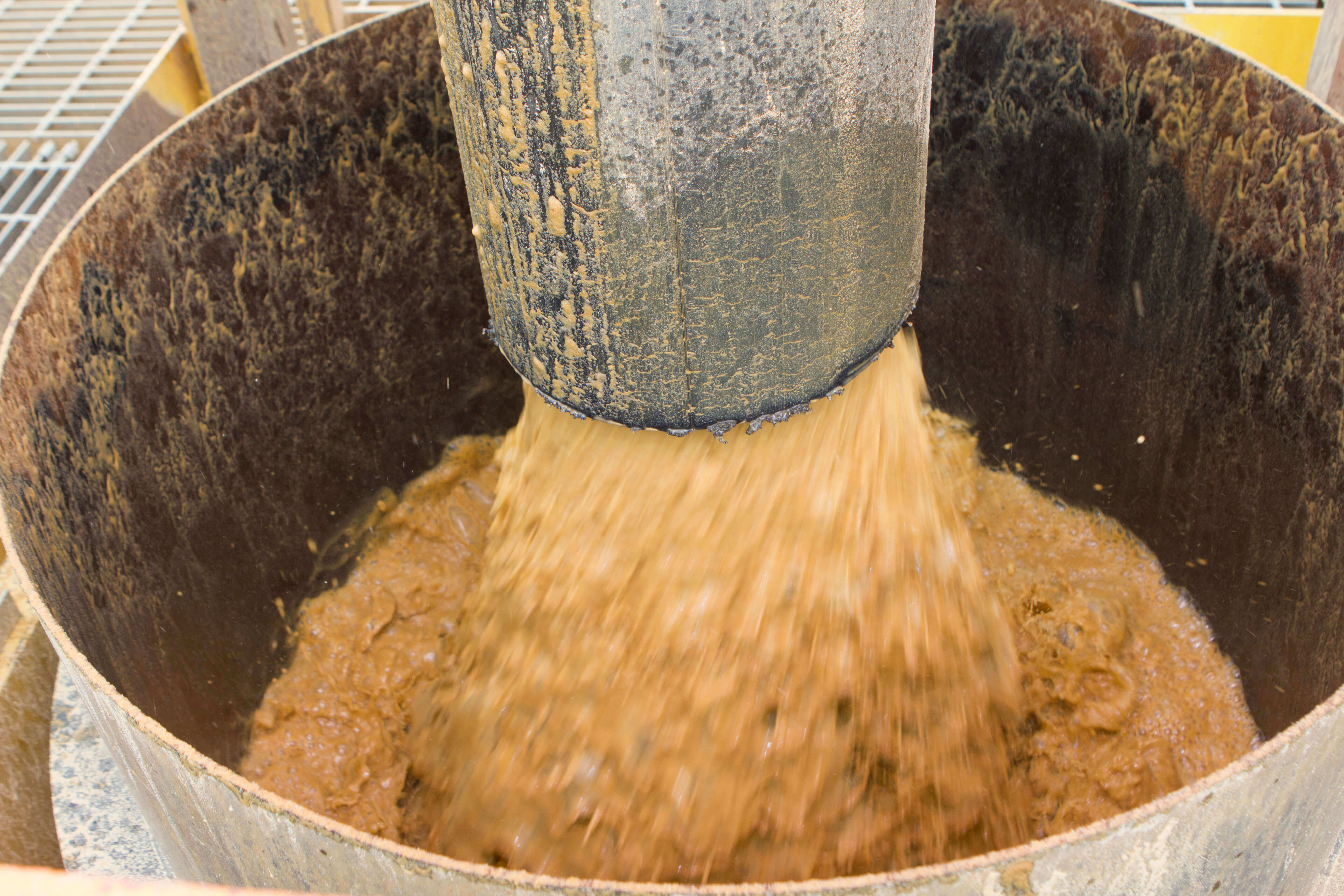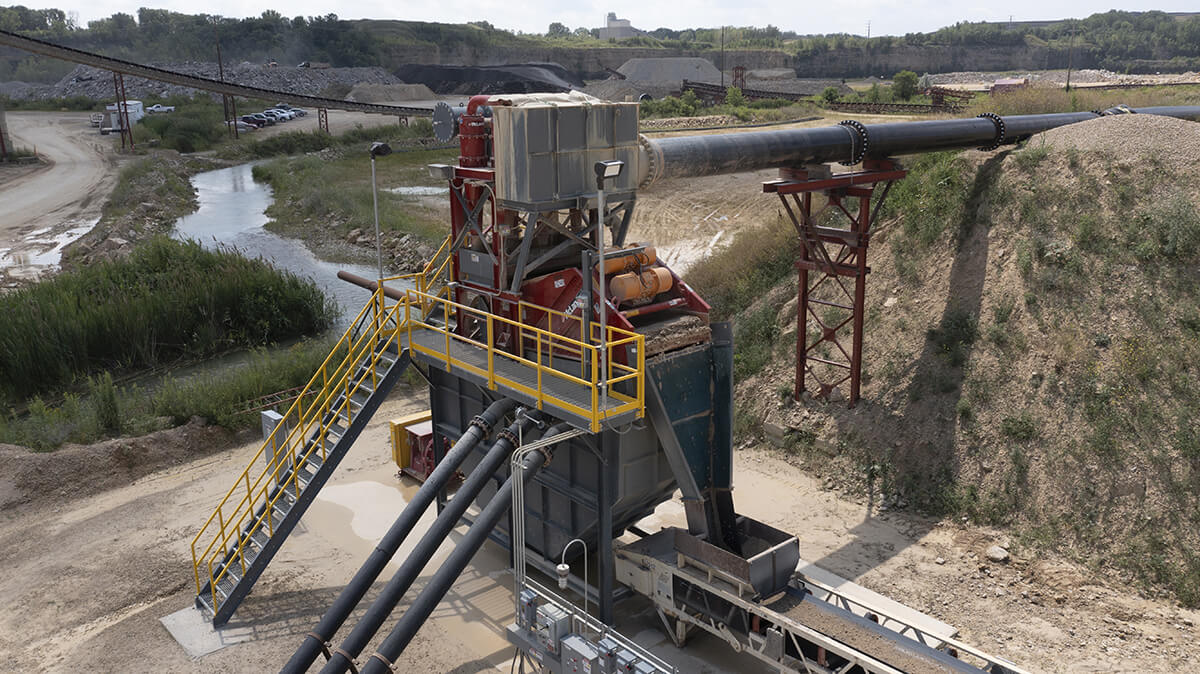Hydrocyclones have a variety of uses, including size classification and fines recovery. They are highly efficient for sizing minus 4 mesh material as well as capturing fine material down to 400 mesh. They offer many benefits, including lower cost, smaller footprint and less maintenance than other types of classification equipment.
Because Hydrocyclones have no moving parts, a Pump is required to feed the slurry to the Hydrocyclone at a designated pressure and volume. Inside the Hydrocyclone, particle separation occurs as a result of opposing centrifugal forces and drag forces. Centrifugal forces draw the coarser particles in the feed toward the outer walls of the Hydrocyclone. These coarser particles then exit through the bottom of the Hydrocyclone.
Drag forces pull the finer particles in the feed toward the center of the Hydrocyclone, where they remain rotating with the fluid until they are removed by an upward air core that is formed as air is drawn into the Hydrocyclone from the bottom.
While a majority of the water is removed with the fines in the overflow, Hydrocyclones are limited in their ability to dewater fine solids to a conveyable state.
A good rule of thumb to remember is that fines follow the water. Therefore, the more fines that are present in the underflow, the more water that will exit out the underflow and the more dilute the underflow will be.
This means that Hydrocyclones used for fines recovery applications will have a more dilute underflow than Hydrocyclones used for particle size classification.

Regardless of the application, however, Hydrocyclone underflow is typically too dilute to convey or stack without some sort of material dewatering prior to moving or stockpiling it. Separators™, which are modified Hydrocyclones, were developed to generate a denser underflow for discharging directly to a stockpile, but even these can benefit from further dewatering in certain applications.
Dewatering with a Dewatering Screen
Dewatering Screens are used to remove excess moisture from minus 4 mesh particles to produce a drip-free material that is conveyable, stackable and available for immediate sale. These dewatering devices provide many additional benefits that result from excess moisture removal, including:
- better housekeeping
- less stockpile drying time
- improved stockpile maintenance
- reduced hauling costs

In a typical process flow, the Hydrocyclones discharge directly onto the Dewatering Screen. The slurry is fed onto the Dewatering Screen’s steep, downward inclined surface. Counter-rotating vibratory motors throw the solids upward and forward, which allows the water to detach from the solid particles and discharge through the openings in the media on the screen’s surface.
The solids material will discharge from the screen in the 10-15% moisture range, though this depends largely on the material being dewatered. In any case, the material coming off the Dewatering Screen will be drip-free, which can be different moisture levels for different materials.
Applications for Hydrocyclones and Dewatering Screens
Dewatering Screens can be used with Hydrocyclones in many applications. A few of these applications include:
- Primary washing, size classification and dewatering
- As part of a system for classification and dewatering
- Fines recovery and dewatering
Washing, size classification and dewatering
Dewatering Screens can be paired with Hydrocyclones that are performing primary washing and size classification to remove moisture from the final product ahead of stockpiling. These Hydrocyclone and Dewatering Screen systems typically are the first stage of sand washing after dry processing through a sizing screen. In this application, the sand is mixed with water in a sump, and then pumped to the Hydrocyclone to perform the classification.

Part of a system
Hydrocyclones can also be paired with Dewatering Screens that are used to dewater underflow from Sand Classifying Tanks or overflow from Screw Washers. In Classifying Tank applications, the underflow discharges directly onto the Dewatering Screen. Any product sized solids that exit through the screen media with the water are captured in a sump beneath the Dewatering Screen. They are then pumped up to a Hydrocyclone positioned above the Dewatering Screen to be recovered and subsequently dewatered with the Sand Tank discharge.
In Screw Washer applications, Hydrocyclones and Dewatering Screens are used to recover product-sized fines and improve the dryness of the final product in one of two ways. The Hydrocyclones can recover product-sizes fines from the screw overflow and discharge them onto the Dewatering Screen, which is placed after the screw for further moisture removal ahead of stockpiling. The Hydrocyclones can also be used to recover product-sized fines that exit with the water through the Dewatering Screen media when placed after a screw for product moisture removal.

Fines recovery
In other types of fines recovery applications, Hydrocyclones and Dewatering Screens can accept the waste stream from the wash plant to reduce the volume of material reporting to settling ponds. These Hydrocyclones are specifically designed to recover ultra-fine particles down to 400 mesh.

As a unit, Hydrocyclones and Dewatering Screens provide a highly efficient classification and dewatering system in a small footprint. They can process high volumes and generate a drip-free in-spec material. When compared with similar types of sizing and dewatering systems, Hydrocyclones and Dewatering Screens offer better classification and more dewatering when used in combination.









